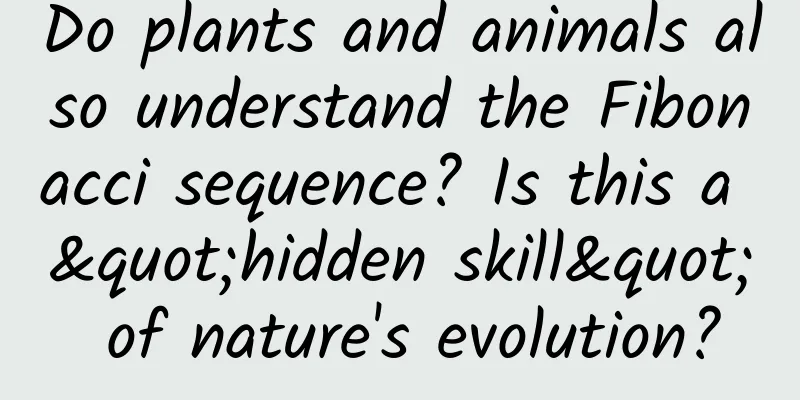Do plants and animals also understand the Fibonacci sequence? Is this a "hidden skill" of nature's evolution?

|
Generally speaking, students who graduate from "high primary school" have probably heard of the mathematical problem of Fibonacci sequence. So, how is this mathematical problem related to biomechanics? And it's so "beautiful"? ! For a long time, mathematics and mechanics were actually inseparable, and now they are still in a state of "close yet distant" and "broken and connected". Let's digress! Let's focus on the beauty of the biomechanics of the Fibonacci sequence and how beautiful it is. 1. What is the Fibonacci sequence? 1. Definition and generation rules of Fibonacci sequence The Fibonacci sequence was originally discovered by Leonardo Fibonacci (1175-1250), a medieval Italian mathematician, when he was studying the phenomenon and law of rabbit reproduction. If each pair of rabbits (one male and one female) can produce a pair of rabbits every month (assuming they are also one male and one female, the same below), and rabbits are able to reproduce two months after birth, and if all rabbits do not die, how many pairs of rabbits can be produced after one year? Let's take a pair of newly born rabbits for analysis. Figure 1 shows that rabbits grow up and reproduce as the months go by. Figure 1 Rabbits grow and reproduce as the months go by Finally, the total number of rabbits forms a sequence: 1, 1, 2, 3, 5, 8, 13, 21... This is the Fibonacci sequence, also known as the "rabbit sequence". The generation rule of this sequence is: starting from the third term, each term is the sum of the first two terms in the sequence, for example: 2=1+1, 3=1+2, 5=2+3, 8=3+5... 2. The relationship between Fibonacci numbers and the golden ratio The golden ratio refers to dividing the whole into two parts, and the ratio of the larger part to the whole part is equal to the ratio of the smaller part to the larger part. The ratio is about 0.618 (as shown in Figure 2), and the reciprocal of this number is 1.618. Isn't it a perfect coincidence? This ratio is recognized as the most aesthetically pleasing ratio, so it is called the golden ratio (in English, "golden XX" is often used to describe XX's perfect and authoritative meaning). It often appears in nature and art and is considered a symbol of beauty. Figure 2 Golden Section Line Now, let's look at the relationship between the Fibonacci sequence and the golden ratio. There is a very interesting phenomenon here. If you take the ratio of two adjacent numbers in the Fibonacci sequence, you will find that as the number of terms increases, the ratio of the previous term to the next term will get closer and closer to the golden ratio. Specifically, when we take two larger consecutive numbers in the Fibonacci sequence and calculate their ratio, the ratio will approach the golden ratio. For example, 21/34 ≈ 0.6176, 89/144=0.6181, which is very close to the golden ratio. Therefore, the Fibonacci sequence is also called the golden ratio sequence. We are all "numerable" people, so what is the significance of knowing this number? For example, the geometric figures related to the golden ratio are the "golden rectangle" and the "golden spiral". The ratio of the length to the width of the golden rectangle is the golden ratio; that is, the short side of the rectangle is 0.618 times the long side. In the golden rectangle, a square is made by three sides, and the remaining part is another golden rectangle. Squares and golden rectangles can be made in turn, and the cycle repeats (Figure 3, left)... Figure 3 Golden rectangle (left) and golden spiral (right) The golden spiral, also known as the Fibonacci spiral, is a spiral drawn according to the Fibonacci sequence. It is made like this: draw a 90-degree fan in a rectangle (i.e., a golden rectangle) made up of squares with Fibonacci numbers as sides, and the connected arc is the Fibonacci spiral (Figure 3 right). There are many Fibonacci spiral structures in nature (Figure 4), which meet the most perfect golden ratio. This is a wonderful design of nature. In biology, the growth process of many animals and plants follows the laws of the Fibonacci sequence, such as the number of petals and the arrangement of scales on the surface of pineapples. This phenomenon is called the "Fibonacci phenomenon" and is a common law in nature. Figure 4 Various Fibonacci spiral structures in nature Why do these animals and plants choose the Fibonacci sequence as their "design blueprint"? What kind of scientific mechanism is hidden behind it? It is so coincidental and so beautiful, there must be a reason. 3. Application of Fibonacci numbers in mathematics and other fields In the field of mathematics, the Fibonacci sequence is widely used. This golden ratio property makes the Fibonacci sequence widely used in geometry and art. For example, the shadow of the golden ratio can be seen in architectural design, painting and sculpture. In addition, the Fibonacci sequence also has important applications in algebra, combinatorial mathematics and number theory. For example, in algebra, the general formula of the Fibonacci sequence is a classic example of a "recursive algorithm". In combinatorial mathematics, many combinatorial problems can be transformed into the problem of solving the Fibonacci sequence. In number theory, the distribution of prime numbers in the Fibonacci sequence and the modular operation properties of the Fibonacci sequence are studied. In computer science, the Fibonacci sequence can be used to implement efficient search and sorting algorithms, such as Fibonacci search and Fibonacci sort. At the same time, the Fibonacci sequence is also widely used in cryptography, data compression and other fields. In finance, Fibonacci numbers are also used to analyze stock prices and market trends. Fibonacci retracement levels are a popular technical analysis tool used to identify points where prices are likely to rebound or reverse. If I were to go into detail, it would be a long list. I will just skim through it here. Next, I will talk about the topic of biomechanics. 2. The biomechanical beauty of the Fibonacci sequence The Fibonacci sequence in nature is an amazing phenomenon. What's the reason? Biomechanics. First, let’s understand a concept - morphology. Morphology is the study of the external form and structure of organisms. It focuses on how organisms adapt to the environment and realize their functions through their form. From the perspective of biomechanics, animals and plants choose the Fibonacci sequence as the basis of their morphological characteristics, probably because they have found in the long-term natural selection process that such a structure can better adapt to the environment and improve the success rate of survival and reproduction . This is the result of survival competition and optimization. It can be understood as an optimization strategy that helps organisms achieve the best results in growth, development and adaptation to the environment. Of course, this is just a general statement of the big truth. The following is a detailed explanation of the small truth. From the perspective of morphology, stability and adaptability are two key aspects that are closely linked to the morphology and function of organisms . Stability refers to the ability of an organism to maintain its shape and structure in the face of external perturbations. In morphology, stability is usually related to the structural strength and rigidity of an organism. Adaptability refers to the ability of an organism to adjust its morphology and structure according to its living environment and needs in order to increase the chances of survival and reproduction. Morphologically, adaptation is manifested as the match between the form and structure of an organism and its living environment. ( 1 ) Analysis of the mechanical problems of the Fibonacci sequence from the perspective of strength By adopting the Fibonacci sequence, organisms are able to use space and resources in an efficient and optimal way while maintaining structural stability. For example, the way branches and leaves of trees branch out in accordance with the Fibonacci sequence (geometric parameters such as branch length and diameter in Figure 5), and the trunk of a tree resists the effects of wind and gravity through its thick base and branch structure, thereby maintaining overall stability . Figure 5 The morphology of tree branches (left) and the morphology of the human vascular tree (right) By simulating the force analysis of wind on plant structure, we can study the influence of Fibonacci sequence on plant structure stability. In order to simplify and explain the principle clearly, we simulate the branch as a cantilever beam for force analysis (Figure 6). Regardless of whether it is subjected to concentrated force or uniform force, the bending moment borne by the cantilever beam (branch) is the largest at the root and the smallest at the tip; if the cross-sectional size of the cantilever beam is equal, then the resulting stress distribution is also the largest at the root and the smallest at the tip, resulting in the root being easily broken due to large force and insufficient strength. In order to avoid this situation, the diameter of the root of the branch is relatively large, and the diameter gradually decreases from the root to the tip . The branches are all this long, which is also easy for everyone to understand. This is a mechanical problem of analyzing the Fibonacci sequence from the perspective of strength . Figure 6: Simulating a branch as a cantilever beam for force analysis From the perspective of force analysis, the widespread application of Fibonacci numbers in nature also makes sense. This stability not only helps trees survive in harsh environments, but also provides them with a stable support, allowing them to grow upward and spread their branches and leaves for photosynthesis. That reader said, branches don’t always grow like this? ! Yes, the shape of branches is also affected by other factors (such as materials, external environment, etc.). I won’t discuss this here. Similar to the shape of branches, the blood vessel tree in the human circulatory system also has a similar shape to branches, which is also affected by the principles of biomechanics (such as Maury’s law, the principle of equal shear stress, etc.) . I won’t discuss this here and continue to analyze the Fibonacci sequence. In plants and animals, many structures present Fibonacci spiral forms, such as the petals of sunflowers, the scales of pine cones, and the shells of conchs. These spiral forms are not only beautiful, but also have strong structural stability. The characteristics of the Fibonacci sequence enable these spiral forms to maintain a stable form during growth, while effectively dispersing the effects of external forces, thereby enhancing the survival ability of organisms. Now, let's imagine a simplified model of the force analysis of sunflower petals. Assume that each petal is subject to two main forces: one is the support force from the flower stem, and the other is the squeezing force from the adjacent petals. Ideally, if the force on each petal is uniform, the structure of the entire flower will be very stable . The way the Fibonacci sequence works here is that it indirectly affects the force on each petal by affecting the number and arrangement of petals . Due to the characteristics of the Fibonacci sequence, the angle between two adjacent petals (if we regard the petals as points arranged around the center of the flower) changes gradually, and this change follows a specific law. This law ensures that each petal has enough space to grow, while also ensuring the structural stability of the entire flower. Specifically, when an external force (such as wind or insect touch) acts on the flower, this force will be dispersed along the spiral arrangement direction of the petals. Due to the characteristics of the Fibonacci sequence, this force is dispersed very evenly, and no part will be subjected to excessive pressure or tension. It's like in a closely-knit army, every soldier can evenly share the external pressure, thus maintaining the stability of the entire team . Friends who are interested and capable can try to use the method of structural topology optimization design to calculate why the shape of sunflower seeds is rhombus-shaped and distributed in the shape of Fibonacci spiral . The result of optimization from the perspective of mathematics and mechanics is the real shape of the sunflower we see. ( 2 ) Analysis of the mechanical problems of the Fibonacci sequence from the perspective of stiffness The distribution of veins in leaves often shows a golden ratio . Professor Guo Xu's team at Dalian University of Technology conducted in-depth research on the mystery of the golden ratio distribution of leaf veins in nature. Based on the bionic research of structural topology optimization theory, they explored the vein distribution configuration that maximizes the stiffness of leaves (Figure 7). Figure 7 Optimal vein distribution configuration of a typical leaf The study found that when the first and second segments of the main vein trunk (A/B) are distributed in an approximate golden ratio, the structural rigidity of the leaf is the largest, that is, the deformation of the leaf is the smallest , so that it has the largest equivalent illumination area and improves the photosynthesis efficiency of the mesophyll tissue. The above results preliminarily confirm that the distribution of leaf veins is the result of evolution driven by the optimization of mechanical properties. The research results can not only explain the mystery of leaf vein distribution, but also provide a very instructive guiding principle for the design of stiffened plate and shell structures such as antennas and flexible electronic devices . ( 3 ) Fibonacci numbers of animals The bone and muscle structures of many animals also present a hierarchical and bifurcated form similar to the Fibonacci sequence, which not only improves the animal's movement efficiency but also effectively protects them from external damage . The shell of the conch presents a logarithmic spiral form (Figure 8, left), which is not only beautiful but also has extremely strong structural stability. When impacted by external forces, this logarithmic spiral structure can effectively disperse the impact force and protect the soft tissue inside the conch from damage. Figure 8 Fibonacci numbers in conch (left) and cats (right) The skeletal and muscle structures of animals' limbs may also be affected by the Fibonacci sequence. For example, studies have shown that the length ratio of the limb bones of cats is close to the Fibonacci sequence (Figure 8, right), and this structure may help improve the efficiency and stability of animal movement. By simulating the forces during animal movement, the effect of the Fibonacci sequence on the stability of animal movement can be studied, which helps them maintain their advantage in survival and competition . The growth process of biological tissues may also follow the Fibonacci sequence. For example, studies have shown that certain cell division methods may follow the Fibonacci sequence, and this growth pattern may help maintain the stability of tissue structure (just like the sequence of rabbits laying rabbits). By simulating the forces during cell division, the effect of the Fibonacci sequence on the growth stability of biological tissues can be studied. ( 4 ) Understanding the stability of the Fibonacci sequence from the perspective of the principle of least action The principle of least action is a fundamental principle in physics, also known as the Hamiltonian principle , and is a fundamental principle in classical mechanics. It states that in nature, the evolution of a physical system always follows a path that minimizes the action . In static or equilibrium conditions, this principle is closely related to the principle of minimum potential energy , because the system tends to seek a state with minimum potential energy, which is a stable state . In biological morphology, this principle can be explained as organisms choosing a morphological strategy that minimizes energy consumption, maximizes resource utilization, and responds to environmental challenges during evolution. For example, sunflower petals are arranged in a spiral manner according to the Fibonacci sequence, which may allow the flowers to expand to the greatest extent when they open while maintaining structural stability. This stability helps protect the flowers from external damage and also allows the flowers to photosynthesize more efficiently. For example, the branch structure of trees and the skeletal morphology of animals can reduce potential energy by reducing bending and twisting, thereby increasing stability. There are also structures such as the scales of pine cones and the shells of nautilus, which all show a beautiful spiral shape, which may have evolved by minimizing energy consumption and maximizing structural stability. ( 5 ) Understanding the adaptability of the Fibonacci sequence from the perspective of the principle of least action The morphology and structure of many organisms show the characteristics of the Fibonacci sequence, such as the number of petals and the arrangement of scales in pine cones. The characteristic of this sequence is that the ratio of its two adjacent terms gradually approaches the golden ratio, which makes the form more harmonious visually. This harmonious beauty of appearance is not the purpose, but the fundamental biomechanical beauty is the reason. In fact, this arrangement of the Fibonacci sequence is a space-filling strategy that allows the petals to expand in a maximized manner within a limited space, thereby maximizing the reception of sunlight and photosynthesis, which helps plants to use space and resources in the most efficient way during growth and development, thereby increasing the chances of survival and reproduction . Therefore, the morphological manifestation of the Fibonacci sequence can be regarded as an adaptive strategy. 3. Summary There is indeed a mysterious and interesting connection between the Fibonacci sequence and nature. This connection not only demonstrates the charm of mathematics, but also reveals the hidden mechanical mysteries in nature. From the perspective of biomechanics, the appearance of the Fibonacci sequence in nature can be understood as an optimization strategy that helps organisms achieve the best results in growth, development and adaptation to the environment. The characteristics of this sequence enable organisms to use space and resources in the most efficient way, maintain a stable form, and effectively disperse the effects of external forces, thereby enhancing the adaptability and survival ability of organisms . Of course, our current understanding of the relationship between the Fibonacci sequence and nature is just the tip of the iceberg. There are still more scientific questions for us to explore and answer in the future. We look forward to friends from all walks of life raising more interesting questions, providing more professional interpretations, and revealing more exciting discoveries. |
>>: These common diseases in spring may happen to you...How to "prevent" them?
Recommend
Five major marketing tactics behind Alipay’s lucky draw, a must-read for SEM!
The screen was flooded with messages! I believe e...
She cultivated a virus to cure her own cancer. Can “self-experimentation” promote scientific progress?
In 2020, Beata Halasi's breast cancer recurre...
Douyin operation: 4 tips to teach you how to create a Douyin hit from scratch!
Regarding "Tik Tok", many people will r...
2014 Mobile Internet Data Report (Full Version)
Mobile Internet information TalkingData released ...
The powerful "king of soil": the "universal soil" in ultra-deep drilling projects
News reports that my country's oil and gas dr...
Master Wang's concept design 3D assisted painting
Course Catalog: ├──c4d and redshift | └──c4d and ...
When doing short video live streaming, how can you obtain real short video industry information?
When making short videos , you often hear two voi...
Danger! An owner knocked down this wall, causing the entire house to become a dangerous building! You must know these when renovating...
Expert: Dr. Xie Qiang, Geotechnical Engineer, Off...
Mid-Autumn Festival shock: Chang'e is actually a toad spirit?
The moon palace must have a special feeling, ever...
One-third of the private car market is occupied by Shenzhou Private Car. Has it been eliminated?
From the moment you pick up your phone to call a ...
Why do girls always have bruises on their bodies when they wake up?
"Honey, what did you do last night? Why is t...
Using body temperature to generate electricity! Scientists develop a new type of thermal conduction generator that is efficient, durable and stretchable
In 1975, the world's first calculator watch w...
Can Nest's launch of the central control application "Google-branded" smart home seize the entry opportunity?
Last week, Google's Nest held a press conferen...
Hotྂhotྂhotྂ! More than 14 provinces and cities are "steaming sauna" together. Check your home to see if it is okay.
Recently, a large-scale wave of "sauna weath...
Is it a tragedy that China Unicom and China Telecom do not have FDD licenses in the 4G era?
Recently, the online article "China Unicom fo...









